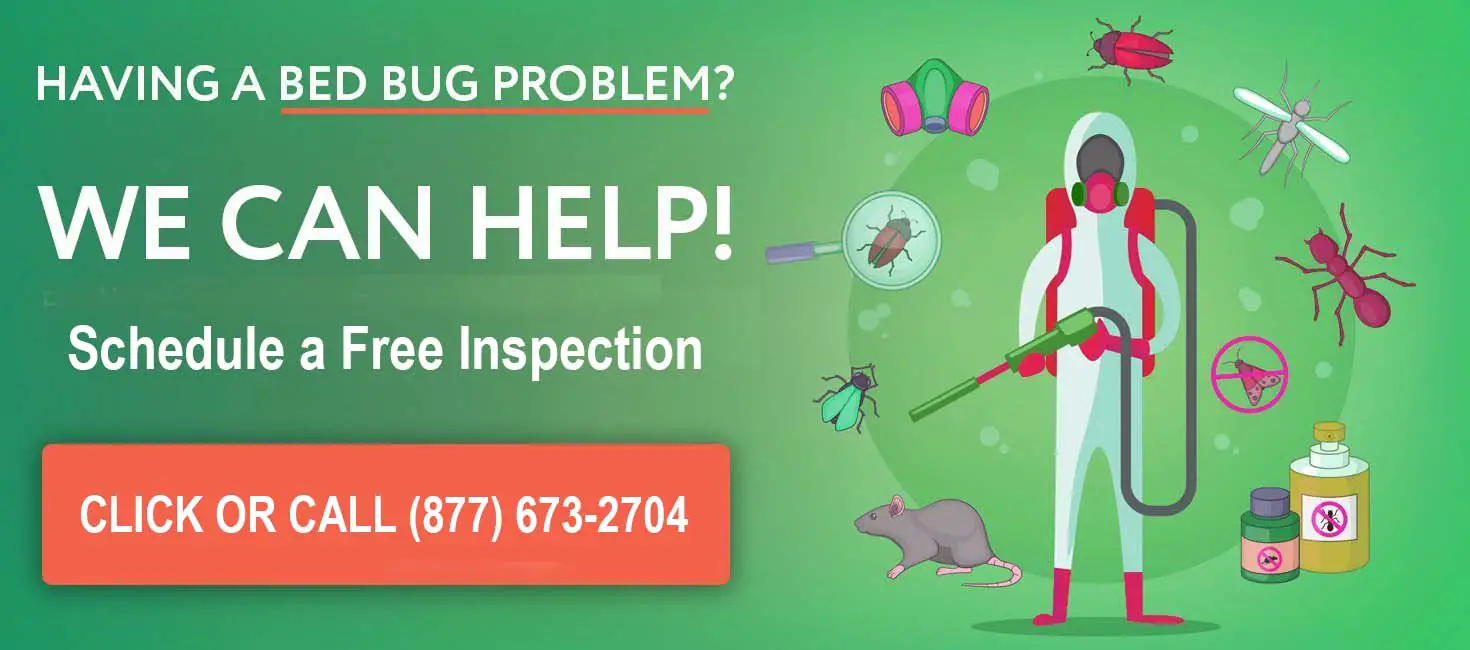overview of causes for bug bites in bed
There are several reasons whey you are experiencing bug bites in bed. Causes include insects or non-insect based reasons as listed below.
Insect Based Causes of Bites
Insect based reasons for what appears to be bites in bed:
- bed bugs (commonly confused with scabies bites which need to be confirmed with a skin scraping)
- fleas
- chicken mites (bird mites)
- scabies mites
- mosquitoes
- spider bites
It
is difficult to identify one cause of body itch or irritation from
another, although each has specific signs. For example bug bites on
elbows could be caused by bed bugs.
Other insects, such as
chigger bites, result in delayed skin reactions that could be attributed
to happening during sleep. It gets even more complicated when you
consider insect such as Dermestid beetles that can cause an allergic
reaction when they molt. Similar reactions can be caused by cockroaches
and dust mites.
Other Causes for Night Bites in Bed
Non insect causes are often confused with insect bites since they have similar characteristics. Often changes in blankets, detergents and food can cause an allergic reaction that is mistaken for an insect bite. Even dry air can result in skin itch, such as what happens when heating systems are turned on at home or at work. If bites are seen all over the body, particularly under areas covered by tighter fitting clothes, then allergy is more likely the cause of skin irritation and rash.
Non-insect causes of skin rash, reactions and irritation includes:
- antibiotic reactions
- food allergy
- staphylococcus infections
- Prurigo
- Grover's disease
- Miliaria
- Dermatitis Herpetiformis
- Itch produced by microscopic fibers of paper or glass
- Diabetes
Since there are many possible causes, we suggest that if you believe an insect is the cause, the you call in an exterminator from a certified network such as Home Advisor . You can also call (877) 673-2704 for experienced .
Causes of bug bites by body location
While biting insects can bite anywhere on the body, some insects tend to bite or cause itching in certain areas:
Bite Location
Bites on Face
Bites on Neck
Bites on Elbows
Bites on Arms
Bites on Wrists
Bites on Ankles
Bites on Crotch
Bites on Waist
Bites on Armpits
Bites on Inside Thighs
Bites on Back of Calves
Bites on Scalp
Bites on Hands
Bites on Legs
Insect Cause
Bed Bugs
Bed bugs, Mosquitoes
Bed Bugs, Mosquitoes
Bed Bugs, Ticks
Scabies
Fleas, Chiggers
Chiggers, Lice (Pubic)
Chiggers, Scabies Mites
Chiggers, Scabies Mites
Scabies Mites
Scabies Mites
Head Lice, Cone Nose Bugs
Spiders
Mosquitoes, Bed Bugs, Ticks
causes by Insect size or appearance
One way to tell what is causing bug bites in bed or at night is to find or determine the size of the insect.
- Bed Bugs: (1/8 inch) red in color, oval
- Rat Mites, Bird Mites: poppy seed size with 8 legs. Gray or red in color.
- Scabies Mites: Live most of life under the skin. They make lines on the skin.
- Head Lice: 1/10: long (2.5mm). They can be seen with the eye. Color is gray/white to tan. Lice have 6 legs and a claw on the end of each leg. Lace also lay yellow eggs at the hair base.
- Pubic Lice: These lice appear to be crab like. They are 1/12 inch (1.5-2.0mm) and appear to be small gray specks.
- Ticks: black in color and about the size of a period before feeding.
For a small fee you can also send an insect to the Cornell University Insect Diagnostic Lab.
bed bugs
Bed bugs are carried into a home on luggage or on clothing
from another locations, or move from an infested apartment to an
adjacent apartment.
Bed Bug Lifecycle
 Bed Bugs at Each Stage of Life Cycle
Bed Bugs at Each Stage of Life CycleBed bug bites usually appear on exposed skin areas during sleep. This
includes the face, hands, lower arms, neck and lower leg. It
is rare for bed bugs to bite the bottoms of the feet. If
this is the case, then the cause is more likely to be scabies. Bites can occur on any exposed skin area, although they are inhibited by clothing. Most bites are reported on the legs and arms.
Bedbug bites are allergic skin reactions and can range from a single red raised round red area to multiple bites. These bed bug bites in bed have a clear center and can appear as a single bite or in a group. In addition to skin irritation, or a bed bug rash, itch is a common symptom.
Bed Bugs Bites in Row Pattern on Arm
 Bed Bug Bites Along an Arm
Bed Bug Bites Along an ArmBites alone do not confirm the presence of bed bugs since the bites are similar to what can be caused by other insects. Other signs of bed bugs include brown or red markings on the mattress, particularly along mattress and box spring seams. You may also smell a raspberry musty smell. You can see bed bugs with the naked eye. To nudge them out of hiding, run a credit card or wire brush inside a bed seam to see if any run out.
Bed bugs will feed on a host for several minutes while the host or human/pet is sleeping. After feeding, they leave the host and return to their hiding place. Bed bugs do not spread disease.
Bed Bug Bite Cure
Symptoms of bed bug bites tend to go away on their own in 1 to 2 weeks assuming the source of the bites has been eliminated. If you are allergic to bed bug bites there are no known allergens that can be used as part of a desensitization program (e.g; allergy shots). The best approach is to get rid of the bed bugs.
How to Get Rid of Bed Bugs
In terms of answering the question how to get rid of bed
bugs, its best to call in an exterminator as these are considered the
toughest insects to identify and kill. Multiple methods are
needed to do the job correctly. Bed bug treatment can be
expensive so be sure to call several firms to ask about costs, methods
used, and guarantees. A good place to start is with Home Advisor (1.877.233.1145) since they provide up to 3 free quotes.
You can also check our bed
bug exterminator database. Treatment can cost
$1000 or more.
If you can't afford a bed bug exterminator, the next best approach is to purchase a bed bug kit. This will contain both the instructions and products needed to do the job correctly. There are products made to specifically help with bed bug itch.
chiggers
Chigger bites occur outdoors, followed by a delayed skin reaction. For this reason, they do not occur as bug bites in bed. Chiggers are small red colored mites that feed on rodents and humans. Chiggers usually feed and then move off of the human host.
Chigger Illustration
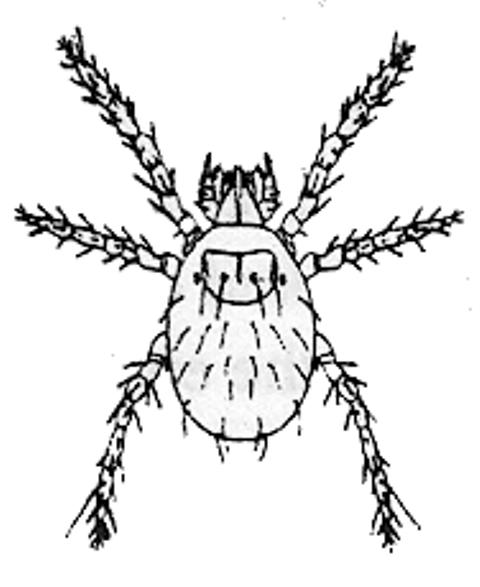 Illustration of a Chigger
Illustration of a ChiggerSource: U of Kentucky
Chiggers will attached to pets or other animals for several days. Chiggers feed at the based of human hair or in a pore. They will feed in areas where clothing is tight to the body such as at the waist or top of a sock. The chigger will attach to the skin and digest lymph from the skin.
Diagram of Chigger Bite Locations
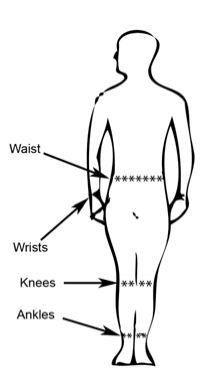 Chigger Bite Locations on Body
Chigger Bite Locations on BodyHuman chigger bites happen when a person moves through a chigger infested outdoor area. The insect repellent Off, which contains the active ingredient DEET, will repel chiggers.
Chigger Bites
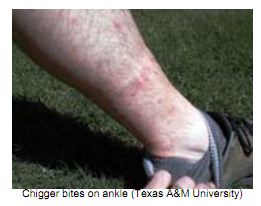 Chigger Bites on Leg
Chigger Bites on LegSource: North Carolina Cooperative Extension and Texas A&M
Chigger bites results in skin itch in 3 to 6 hours, with a chigger bite or skin irritation forming after 10 to 16 hours. In severe chigger bite reactions in highly allergic people, blisters can form. They do not cause disease. Products providing chigger itch relief include calamine lotion, oral Benadryl or a prescription steroid cream.
Chiggers or Bed bugs
When comparing Chiggers to bed bugs, it can usually be differentiated based on bite location. Chiggers congregate in body areas that are constricted by clothing. Bed Bugs are just the opposite. Chiggers are found in the ankles, crotch, waistline and armpits, all areas where bed bugs usually do not bite.
Bird mites
Bird or chicken mites live on birds and enter homes by moving from a
bird nest into the home.
When this happens they use humans as a host. Bird mites are
found throughout the United States. They are whitish in color before
feeding and turn red after feeding. As the blood is digesting
they will turn a black/gray color. Bird mites have 8 legs and are oval
shaped. The are small at 1/32 inches (.75mm).
They are also introduced into the home on birds kept as pets
and sometimes from gerbils (gerbil mites).
Bird or Chicken Mite
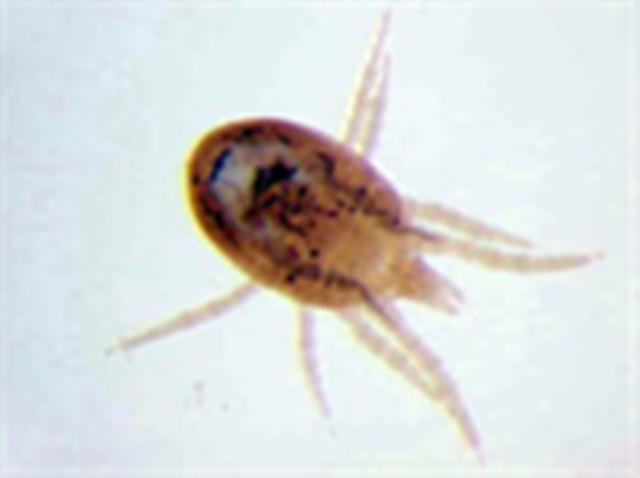 Bird or Chicken Mite
Bird or Chicken MiteChicken or bird mites become a problem when they move from nest located on the outside of a home, and then migrate into the home through the attic or window frame. They feed on the skin and then fall to the ground after feeding. Bird mites can spread a disease called St. Louis encephalitis and a skin reaction.
The mites rapidly reproduce with the mite going through a generation in 7 to 12 days. Like bed bugs, they hide in small cracks/crevices during daylight and feed on humans at night. The bites can cause skin irritation and itch. To help with the itch consider a topical such as Aveeno.
Bird Mites or Bed Bugs
Bird mites will bite any part of the body. Humans are not a good host for the mite, causing them to die in about 3 weeks. They can live for up to 4 to 5 months. When comparing bird mites or bed bugs, consider if you can find other signs of bed bugs such as mattress stains.
Killing Bird Mites
Call an exterminator such as Home Advisor (1.877.233.1145) if you have a bird mite infestation as you will want to start bird mite treatment as early as possible. Be sure to wash all bed linen in hot water to kill any mites that might have fallen into the bed. Vacuum all rooms thoroughly.
Prevention involves avoiding nest formation on a home, such as in a chimney. After birds abandon a nest, quickly remove it. Do not handle nests with your bare hands. If no hosts are available, mites can survive for about 8 months without feeding.
flea bites
A flea will feed on any warm blooded mammal. The most common type is
called a cat flea, which is often brought into the home by a pet such
as a cat or dog, or on a rodent. Fleas are a dark red/brown color,
flat and are 1/2 inch to 1/6 inches long. When they move,
they look compressed, as if they are walking on their edge. They have
antennae
and are found throughout the United States. Flea bites can
happen to a pet or a human. They can survive on a host for 30
to 50 days. Flea season is spring and early summer, but are
found year round.
Flea Biting Skin
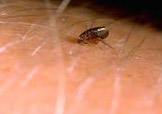 Flea Biting Skin and Taking Blood Meal
Flea Biting Skin and Taking Blood MealSource: CDC
Fleas can jump up to 8 inches high, 16 inches along a floor allowing them to leap onto a host. Once on a host, fleas do not leave. They are often found on the lower legs ,as they leap onto the host. Fleas can transfer a disease called the Bubonic Plague and the bacterial infection murine typhus. In pets, fleas can spread tapeworms.
Cat fleas will lay flea eggs on the host (20 to 50/day) and will hatch in two to five days. The eggs are small, 1/32" and are white ovals in shape. Eggs often fall off the host landing on the bed, and carpet. Flea larvae are 3/16" and look like a worm with no legs or eyes. Larvae will feed off of dried blood left behind by adult fleas. The larva will move around for 8 to 15 days and then build a cocoon before becoming an adult. They will leave the cocoon under normal room temperatures in about eighteen days.
Cat Flea Larva
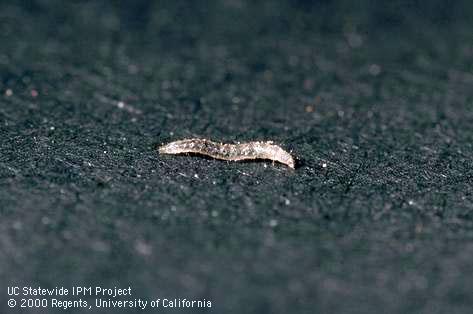 Cat Flea Larva
Cat Flea LarvaSource: University of California
The most common reaction in humans is a skin reaction due to flea allergy. Reactions are small red bumps which itch. Fleabites are small and round, With some swelling and are mostly found on the ankles and lower legs. Children sometimes break out in hives called urticaria. They can spread a disease called cat flea rickettsiosis with symptoms that include a skin rash, vomiting, fever and chills.
Pets can suffer hair loss and other allergic reactions called fleabite allergic dermatitis. This also is accompanied by itch. Itching in pets and humans can last for 5 days.
To prevent a flea infestation, be sure to bathe and groom pets. Use a flea preventative for pets such as Frontline for Cats or Dogs. These spot ons are applied to the coat every 1 to 3 months. Other products can be added to food or provided as a pill. A flea comb can help during grooming to remove fleas. If a dog is infested, consider using a dog/cat flea dip first combined with the use of a flea comb. No matter which method selected, always follow the manufacturers directions.
Be sure to vacuum the home thoroughly (for 10 days to 2 weeks) and wash
all of your pets belongings in hot
water with detergent. As an added level of protection clean
the home with a disinfectant formulated to kill parasites such as Benzarid.
If you have a carpet, the product FleaBusters
can help to kill any fleas that are hiding.
Treating outdoor areas is not generally considered necessary.
mosquito bites and Gnats
Mosquito bites are common in warmer months. They come in a variety of colors, but are most often a pale brown. They have 6 legs and are oval shaped. Mosquitoes are 1/4" to 3/8" in size and are found throughout the United States.
Dorsal (Head) View of Bed Bug
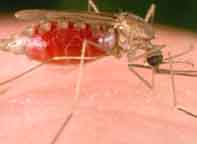 Mosquito Feeding on Skin A Cause of Bug Bites in Bed
Mosquito Feeding on Skin A Cause of Bug Bites in BedSource: CDC
Only female mosquitoes feed on human blood and are most active just after dawn to dusk. A mosquito can fly up to 14 miles in search of a blood meal. They can spread diseases such as Dengue Fever, Malaria and West Nile Virus.
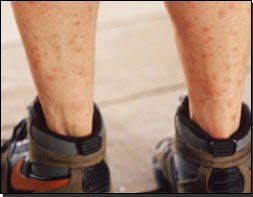 Mosquito Bites on Legs That Look Like a Random and Disorganized Colleged of Bites
Mosquito Bites on Legs That Look Like a Random and Disorganized Colleged of BitesMosquito prevention starts with eliminating places where they can breed such as any standing water (bird baths, ponds, pools). Insect repellents such as Off (DEET active ingredient) can help to minimize mosquito bites.
scabies bites (common to confuse with bed bugs)
Scabies Rash on Back
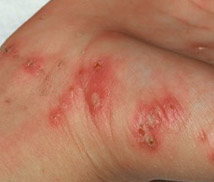 Scabies Rash
Scabies RashScabies mites will feed on humans or pets. The mites will burrow into
human skin, but cannot complete their lifecycle on a human.
The result on the skin is the development of a scabies rash.
The mites are 1/16" in size.
A female scabies mite lays 3 eggs per day under the skin for a total of 200. It takes 3 to 4 days for the eggs to hatch. As the nymphs (baby mites) hatch, they emerge from the skin, they start to molt. Scabies symptoms include skin rash (often referred to as scabies bites) and severe itch. Scabies symptoms appear several weeks after the infestation has started.
The scabies nymphs then burrow into the skin as they molt to become adults. Most scabies mites are found between the fingers (in lesions), on the wrists, sides of the feet, genitals, and at the bend of the elbows and knees.
Scabies Bites Location
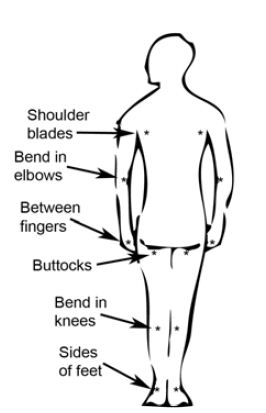 Common Lcoations of Scabies Bites - Not Technically a Bite, But Burrowing Under Skin
Common Lcoations of Scabies Bites - Not Technically a Bite, But Burrowing Under SkinThe scabies mites spread through personal contact, such as shaking
hands or by touching a dog with scabies. Most infestations
only involve a few mites. The itch can spread all over the body. The mite can be spread from person to person through contact. Mites can also walk from one host to the other.
Scabies Treatment involves the use of a topical such as Scabisil (or see your dermatologist).
Often an entire family needs to be treated, since there is a time lag
in terms of identification of the scabies problem, allowing them to
spread to other family members.
The home should also be disinfected including the cleaning of all linen and clothes in hot water (particularly underwear requires frequent washing).
Foggers and other scabies extermination methods do not work as the mites cannot live off of a human host for more than 24 hours.
Scabies or Chiggers
Scabies or Chiggers Bites Comparison
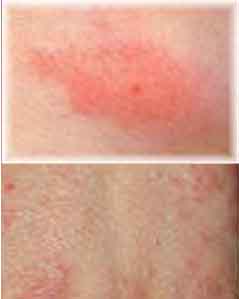 Chigger Bite (top) vs. Scabies Bites (Bottom)
Chigger Bite (top) vs. Scabies Bites (Bottom)Scabies burrow under the skin and are found on the hands or wrists. Rash can occur in areas that do not have scabies under the skin such as the wrists, waist, inside thighs and backs of the calves. For scabies you can see where they burrowed under the skin.
Chiggers bite the skin, often through clothing.
spider bites (rare)
Human spider bites tend to be accidental, when a person comes in direct contact with the spider. Common house spiders pose no threat to humans and are rare since there are few insects if any to feed out. They do not seek out humans to bite.
Adult Female Bed Bug
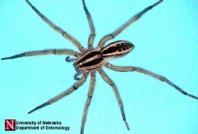 The Wolf Spider is a Rare Cause of Bug Bites in Bed
The Wolf Spider is a Rare Cause of Bug Bites in BedSpider bites are usually of no concern and show little to no reaction. However some people are highly sensitive and show more of a skin reaction. Of course, extremely poisonous spiders such as the brown recluse or the black widow spider can cause serious injury. If bitten by one of these poisonous spiders, immediately apply an ice pack and call for medical help.
Spider Bite Symptoms
Spider bite symptoms range from a minor skin reaction to something more severe. It is rare for a spider bite to cause death. Typical spider bite symptoms include:
- Itching or rash
- Pain radiating from the site of the bite
- Muscle pain or cramping
- Reddish to purplish color or blister
- Increased sweating
- Difficulty breathing
- Headache
- Nausea and vomiting
- Fever
- Chills
- Anxiety or restlessness
- High blood pressure
If spider bites are a problem in a home, it is usually due to the existence of other insects that spiders like to feed on. Spider infestations are removed with vacuuming and removing webs. Insecticides are available to rid a home of spiders.
When seeking treatment, try and bring a sample spider with you for identification.
ticks
Tick Rash on Skin
 Tick Bite Bullseye
Tick Bite BullseyeTicks often cause a purple ring that surrounds a bright red spot. The bites can also cause lesions and inflammation. Two types of ticks, the western blacklegged tick and the blacklegged tick leave a bulls-eye rash. The Rocky Mountain wood tick leaves a rash that appears on day 2 to 5 after the bite occurs. This tick bites the wrists, back or ankles. The rash can spread all over the body.
brochure
This free brochure provides additional information on bug bites in bed.
Questions and answers
Ask a Question or Share Your Bed Bug Experience With Others
Do you have a question or great story about bed bugs? Share it!
references
Centers for Disease Control
University of North Carolina Cooperative Extension
University of California
Dog
Health Handbook
